Science / Functional Breathing Technique
Functional Breathing Techniques and Breathing Exercises for Health and Sports Performance
This is your complete guide to functional breathing. Try some simple breathing exercises. And to learn how to:
- Boost your sports performance
- Improve your health, long-term
- Enhance focus, concentration, posture, and sleep
- Reduce anxiety and breathlessness
- Run without triggering exercise-induced asthma
Welcome to an inspiring new experience with the breath! By making small changes to your everyday breathing, you can achieve significant gains in health and wellbeing. Whatever your starting point.
With that in mind, let’s “take a breath” and dive right in!
- Thirty Functions of The Nose
- How to Breathe While Running
- How to Stimulate the Vagus Nerve
- What is a Breathing Pattern Disorder?
- Measure Your Breathing
- Nose Breathing: Benefits for Sports and Sleep
- Mouth Breathing: Its Effects on Your Face Shape and Your Sleep
- Holding Your Breath: Benefits and Science
- Exercise Induced Asthma: Symptoms, Treatment and Causes
10 Simple Breathing Exercises to Restore Functional Breathing, Reduce Stress and Anxiety, and Improve Physical and Mental Fitness


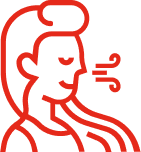
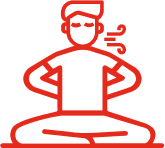
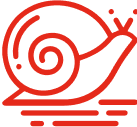
Breathing Recovery
Activate Your Diaphragm
Breathe Light
Breathe Deep
Breathe Slow

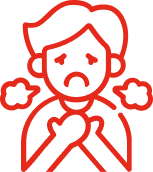
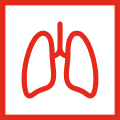
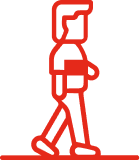

Humming Bee Breath
De-Stress at Work
Box Breathing
Wearing the Buteyko Belt
Breathe Through the Nose During Rest, Exercise and Sleep
Breathing Recovery
- Take a normal breath in through your nose and out through your nose.
- Pinch your nose to hold your breath for up to 5 seconds.
- Count 5, 4, 3, 2, 1.
- Let go of your nose and breathe normally through it for 15 seconds.
- After a normal exhalation, pinch your nose to hold your breath.
- Count, 5, 4, 3, 2, 1.
- Let go of your nose and breathe normally through it.
- Continue the exercise for 5 minutes, or until symptoms clear.
This exercise is suitable for everyone, except those with serious health concerns or in the first trimester of pregnancy. If you are experiencing an asthma attack, it is important that you take your medication.
Activate Your Diaphragm
An easy way to activate your breathing muscles and give your diaphragm a gentle workout.
- Lie on the floor with a small pillow under your head and your knees bent.
- Place a book on your tummy, just above your belly button.
- Bring your attention to your abdomen.
- As you inhale, gently guide the book upwards.
- As you exhale, gently guide the book down.
- During the inhalation, imagine your belly inflating slightly. As you exhale, imagine it relaxing, deflating gently of its own accord.
- Continue the exercise for five minutes.
This exercise is suitable for everyone, except those with serious health concerns or in the first trimester of pregnancy.
Breathe Light
This breathing exercise forms one of the main pillars of the Oxygen Advantage® technique. It uses a light, tolerable feeling of air hunger to alter your breathing biochemistry, reduce your sensitivity to carbon dioxide and improve oxygenation. It is a useful breathing exercise for anxiety, and to gradually reduce breathlessness and fear of suffocation.
During the exercise, carbon dioxide levels increase in the lungs and blood. This sends signals to your body to relax. You may notice an increase of watery saliva or warmth in your hands. If you experience a dry mouth, cold hands, or feel that your breathing is about to become chaotic, take a break from the exercise for about a minute before continuing.
- Sit up straight in a chair. Imagine a piece of string gently pulling you up from the crown of your head.
- Begin to observe your breath as it enters and leaves your nose.
- Feel the colder air entering your nose, and the warmer air leaving your nose.
- Gently reduce the speed of each breath.
- Your breathing should be so quiet that the fine hairs in the nostrils do not move.
- Breathe light for 30 seconds to create a light air hunger.
- Rest and breathe normally for 1 minute.
- Repeat this sequence 5 times.
This exercise is suitable for everyone, except those with serious health concerns or in the first trimester of pregnancy.
Breathe Deep (Diaphragm Breathing)
A second version of the Breathe Light exercise, Breathe Deep helps to activate your diaphragm and prepare your body for slow breathing practice. It calms your breathing and your mind. The aim here is to breathe gently. Try not to take a disproportionately large volume of air into your lungs.
During inhalation, your diaphragm moves down into your abdomen. This produces intra-abdominal pressure that causes your ribs to expand. If you feel too strong a need for air at any point during this exercise, take a rest for 20-30 seconds and start again. Don’t deliberately interfere with your breathing muscles, hold your breath, or freeze your breathing. Breathing should be smooth and calm.
- Sit up straight in a chair or cross-legged on the floor. Imagine a piece of string gently pulling you up from the crown of your head.
- Place your hands on your sides at the height of your lower ribs and relax your shoulders.
- Now, take a silent breath in through your nose. As you inhale, feel your ribs move outwards.
- Exhale gently and smoothly, feeling your ribs move inwards.
- Take slightly fuller breaths, but fewer of them.
- As you breathe in, feel your ribs expand. As you breathe out, feel your ribs contract.
- Breathe silently. There is no need to hear your breathing.
- Continue the exercise for 5 minutes.
This exercise is suitable for everyone.
Breathe Slow (Resonant or Coherent Breathing)
The focus of this breathing exercise, which is another variation of the Breathe Light technique, is to slow the breath to between 4.5 and 6.5 breaths per minute. Countless studies prove that this is the optimal rate for heart rate variability (HRV), oxygen uptake and delivery, nervous system balance, blood pressure control and many other functions in the body. As you slow your breathing, be sure not to take in a disproportionately large volume of air. Breathing should remain light throughout.
- Sit up straight in a chair or cross-legged on the floor. Imagine a piece of string gently pulling you up from the crown of your head.
- Relax your shoulders.
- Take a soft, silent breath in through your nose.
- Exhale softly through your nose.
- Slow down your breath to inhale for 5 seconds: In, 2, 3, 4, 5.
- Exhale for 5 seconds: Out, 2, 3, 4, 5.
- Continue the exercise for 10 minutes.
This exercise is suitable for everyone, except those with serious health concerns or in the first trimester of pregnancy. If you have a low BOLT score (see the article Measure Your Breathing) or fear of suffocation, start with Breathe Slow 3:3, inhaling for 3 seconds and exhaling for 3 seconds.
Humming Bee Breath (Bhramari Pranayama)
This breathing technique is useful if you have allergies, and to give your immune system a boost. It also activates your brain, increasing theta and gamma brain wave activity. Theta waves are associated with creativity and intuition and connected to memory and emotion. Gamma waves are related to states of peak concentration.
The immune system benefits of this exercise are due to nasal nitric oxide, which increases exponentially in the airway during strong humming. Nitric oxide is antiviral, antifungal, and antiallergenic, making this a great breathing exercise if you want to build immunity against COVID or rhinitis.
- Sit upright in a straight-backed chair.
- Breathe in through your nose.
- As your diaphragm engages, you will feel your lower ribs move outwards.
- Inhale for 5 seconds. Exhale for 15 seconds.
- As you exhale, hum.
- Repeat the pattern of slow inhalations and humming, continuing the exercise for 5 minutes.
This exercise is suitable once your BOLT score is 15 seconds or more
De-Stress at Work
This breathing exercise uses long exhalations to hack the nervous system, de-activating your stress response. It is more effective than pursed lip breathing, because blowing through your mouth reduces carbon dioxide levels in the lungs and blood. Low CO2 is synonymous with anxiety and panic symptoms.
You can practice this breathing technique at your desk, while standing at the water cooler, in the restroom — anywhere you can take a minute to be quiet.
You can even use it during a meeting, phone call, or mid-conversation!
- Take a soft, silent breath in through your nose.
- Exhale softly and slowly through your nose.
- As you breathe in, focus on the air as it enters your nose.
- As you breathe out, gently extend your exhalation.
- Inhale for 3 seconds, and exhale for 5 seconds.
- As you focus on your breath, bring a feeling of relaxation to your body.
- Continue the breathing exercise for 90 seconds.
This breathing technique is suitable for everyone.
Box Breathing
Box Breathing is a breathing technique used by the military to create a relaxed state of readiness and get in the zone. It reduces stress and is a great mood booster too. It involves counting the four phases of the breath — inhale, retention, exhale, retention — with an equal ratio, called sama vritti in Sanskrit.
- Sit up straight in a chair, placing both feet flat on the floor.
- Imagine a piece of string gently pulling you up from the crown of your head. Relax your shoulders.
- Breathe in gently and slowly through your nose for 4 seconds.
- Hold your breath for 4 seconds.
- Breathe out gently and slowly through your nose for 4 seconds.
- Hold your breath for 4 seconds.
- Repeat the pattern, continuing the exercise for 5 minutes.
If your BOLT score is very low, use 2 second counts instead of 4 second counts during the Box Breathing exercise. Pregnant women must not practice any exercise involving breath holding.
Wearing the Buteyko Belt
The Buteyko Belt was designed by OA founder Patrick McKeown to help with the practice of breathing exercises. Many of us simply breathe too much air. Just like eating too much food becomes “normal,” because the body adapts to over-eating, over-breathing is a self-perpetuating habit. Mouth breathing, and fast, upper chest breathing contribute to all sorts of health problems.
To correct shallow breathing, we need to connect with the diaphragm muscle, and begin strengthening it. And we need to reduce the volume of air we breathe, so our blood chemistry begins to normalize. To do this, you can wear the Buteyko Belt for periods throughout the day and night.
- Place the belt around your middle.
- Use the straps to tighten the belt so you feel a comfortable level of resistance.
- As you breathe in, your ribs should push the belt gently outwards.
- As you breathe out, the belt should push your ribs gently inwards.
- You can practice Breathe Slow while you wear the belt.
- Wear the belt for 20 minutes at a time, while you’re walking, driving, or working. Or wear it during sleep to reduce breathing volume and lessen the risk of snoring.
This exercise is suitable for everyone, unless you are pregnant or have serious health issues. You can buy the Buteyko Belt in our store.
Breathe Through the Nose During Rest, Exercise and Sleep
This is a breathing technique to carry with you, day, and night. Many of us breathe through an open mouth some of the time, even during rest. But nose breathing is the foundation of healthy breathing, and healthy breathing is fundamental to overall wellbeing.
During exercise, it is common to open the mouth to breathe. This causes exercise-induced bronchoconstriction and is less efficient in terms of oxygenation. Mouth breathing during sleep contributes to bad breath and tooth decay, along with many health problems including sleep apnea and heart disease.
- Make a commitment to switch to nose breathing.
- Begin by taking a moment to notice how you breathe at various points throughout the day. You may find that when you are walking, working out or concentrating on a task, your mouth is open. Many of us inhale through our mouths before speaking.
- Notice if you wake up with a dry mouth in the morning. If you do, it’s likely you breathe through an open mouth during sleep.
- When you exercise, you may need to slow down until you get used to nasal breathing. At first, the air hunger will be tough.
- Your nose will run during exercise. Bring a tissue.
- When you sleep, you will need to use a support such as MYOTAPE.
- If you often or always breathe through an open mouth, you can use MYOTAPE during the day to retrain your breathing.
This exercise is suitable for everyone. If your nose is blocked, use the Breathing Recovery exercise to clear it. If you have a physical obstruction in your nose, try using Nasal Dilator, and speak with your doctor. You can buy MYOTAPE and Nasal Dilator in the OA store. When using MYOTAPE always follow the precautions on the packet.
If you want to develop a personal program of functional breathing exercises — to improve your breathing, reducing stress, anxiety, fatigue, and symptoms of chronic illness — it’s worth working with an Oxygen Advantage® instructor for personalized advice. But if you just want to try some of the techniques, here are ten breathing exercises to get you started. You can make time for a morning breathing practice or integrate the techniques into your day.
- Set time aside each day to pay attention to your breathing.
- Begin with a short practice — two minutes is better than nothing!
- Practice while walking, in the car, in the shower, while watching TV… You take the breath with you everywhere, so once you are familiar with the exercises, it’s easy to integrate them into your day.
Functional Breathing Exercises: Your Questions Answered
What is the Purpose of Breathing Exercises?
The exercises in the functional breathing training aim to eliminate mouth breathing, normalize breathing volume, restore the balance of blood gases, and build diaphragm strength. This reduces breathlessness, and symptoms including asthma, anxiety, and stress. And it enhances sleep, for better all-round health.
Breathing pattern disorders affect around 10% of adults. But dysfunctional breathing is much more prevalent than you might realize. A whopping 75% of people with anxiety have a diagnosable breathing problem.
A breathing pattern disorder is a condition in which breathing is problematic and produces symptoms including breathlessness. It manifests in traits such as fast, upper-chest breathing, big breathing, breathing that is audible during rest, sleep disordered breathing, and irregular breathing with frequent involuntary breath-holding, yawning, or sighing.
How Often Should You Use Deep Relaxing Breathing Techniques?
You can use the breathing techniques as often as you need. If you have chronic stress and high blood pressure, practice first thing in the morning, before sleep, and once per hour throughout the day. This will improve your BOLT score and reduce symptoms. However, when using the relaxing breathing techniques, it is important not to confuse “deep” breathing with “big” breathing. Breathe “low” rather than “deep” and you will avoid breathing too much air.
What Exercise is Good for Shortness of Breath?
The Breathe Light exercise and the Breathing Recovery exercise are both excellent “emergency” breathing exercises. They help bring breathing under control in the moment. Used consistently, they also reduce sensitivity to carbon dioxide. This reduces feelings of breathlessness and improves your breathing capacity.
Why do I Yawn When I do Breathing Exercises?
Many breathing techniques bring your body and mind into a state of relaxation by activating the vagus nerve. If you have been experiencing chronic stress or poor sleep, the exercises will make you yawn as your nervous system calms down.
However, frequent yawning is indicative of a breathing pattern disorder. When you yawn, you blow off excess carbon dioxide, unbalancing your breathing chemistry. If you do find yourself yawning, follow each yawn with a 5-second breath hold after exhalation to restore CO2 levels to normal.
I’m Not Sure How to Breathe During Exercise. What’s the Best Way?
If possible, breathe through your nose to exercise. Unless you are a professional athlete, in which case you will nose-breathe for around 50% of training. You can find out more in the article How to Breathe While Running.
Should I do Breathing Exercises While I Have COVID?
You can practice the gentle exercises listed below to clear your nose and support your recovery. Do not practice any exercises that involve stress, mouth breathing or deliberate hyperventilation.
What Kind of Breathing Exercises are Good for COVID?
If possible, practice breathing only through your nose, during rest and sleep. If your nose is blocked, use small breath holds to clear it. You can also practice slow breathing and humming. Humming will increase antiviral nitric oxide in your airways. Do not practice any exercises with air hunger, or any breath holds, until you have fully recovered. Stress can exacerbate symptoms and contribute to Long COVID.
Can Breathing Exercises Help Protect you from COVID-19?
Nasal-only breathing acts as a first line of immune defense. This is partly due to nasal nitric oxide, which inhibits viral replication in COVID. It is also thanks to the filtering functions of the nose. If you breathe through an open mouth, you are likely to breathe more viral particles straight into your lungs. Even if you’re wearing a face covering.
Humming to increase nitric oxide production may be helpful. Mouth taping during sleep may reduce viral load. And any breathing exercise that reduces stress will naturally and gently support your immune system.
What is the Best Breathing Exercise for Anxiety?
Anxiety is characterized by fast, hard, upper chest breathing. Any breathing technique that normalizes everyday breathing will gradually reduce anxiety symptoms. Conscious breathing helps anchor you in the present, calming the mind. And a healthy level of blood carbon dioxide will calm the breath, so you aren’t teetering on the edge of symptoms.
If anxiety is chronic, work to balance your nervous system by breathing slow and deep. When you’re in a state of panic, the Breathing Recovery exercise can be really helpful.
What is the 4 7 8 Breathing Technique?
The numbers 4, 7 and 8 refer to phases of the breath and their ratio. In 4-7-8 breathing, you inhale through your nose for a count of 4. Hold the breath on the inhale for a count of 7, then exhale for a count of 8, through your mouth.
Oxygen Advantage® does not recommend this method. It is better to maintain soft, silent nose breathing on inhalation and exhalation, whenever possible. Exhaling through the mouth can cause nasal stuffiness and dehydration. If you want to slow your breathing, use the Breathe Slow exercise instead. This focuses on a breathing rate that has proven benefits. To boost mental focus, use Box Breathing.
Can Breathing Exercises Help Me Lose Weight?
When we lose weight, 80% of the fat we burn leaves the body through the lungs as carbon dioxide. But heavy breathing isn’t going to help you shed the pounds. The good news is, by reducing your sensitivity to carbon dioxide, your exercise capacity will increase. Normally, our exercise capacity is limited by our breathing capacity. So as your breathing capacity improves, you will find it easier and more enjoyable to exercise, and this will help you lose weight. Your digestion will improve too as your nervous system comes into better balance.
You may even find that, as you develop a breathing practice, you are more motivated to eat healthily and prioritize deep sleep. Poor sleep is related to obesity, as sleep loss creates hormonal imbalances that trigger over-eating. So no, you won’t lose weight immediately you start, but breathing exercises can definitely support your weight-loss journey.
Can Breathing Exercises Improve Lung Function?
Yes. Breathing exercises that engage and strengthen the diaphragm can improve lung function. Lung capacity increases when you breathe through your nose and engage the diaphragm, while habitual mouth breathing reduces lung function. Breathing at six breaths per minute is known to improve lung function by optimizing the exchange of oxygen and carbon dioxide.
In healthy people, lung function fluctuates throughout the day. If you have asthma, these fluctuations are much more significant, especially at nighttime. Breathing exercises can help correct the over-breathing that triggers nocturnal asthma symptoms. And scientists have even shown that breathing exercises can improve lung function in patients with type 2 diabetes.
Can Breathing Exercises Reduce Blood Pressure?
Yes, reduced breathing and relaxing breathing exercises can reduce high blood pressure by improving the function of the blood pressure receptors, enhancing circulation and blood-vessel function, and balancing the nervous system.
If you have high blood pressure, it is very important that you practice the right breathing exercises. Avoid any medium-to-strong breath holds, voluntary hyperventilation, or anything that stresses the body. Instead, focus on gentle and consistent functional breathing training.
Can Breathing Exercises Help Headaches?
Breathing exercises may help menstrual and stress-related headaches. Functional breathing training may also reduce headaches by improving posture in the neck and tongue, reducing jaw clenching. And breathing exercises support better sleep too, meaning you’re less likely to get headaches because of tiredness.
Can Breathing Exercises Help Sleep Apnea?
A regular functional breathing practice can reduce snoring and sleep apnea. Sleep apnea symptoms, including apneas and oxygen desaturation, are much worse when you breathe through an open mouth. By restoring nasal breathing and normalizing your breathing volume, you are much less likely to experience airway collapse during sleep. Nose breathing also prevents CPAP non-compliance. You can find more information and breathing protocols for sleep apnea in Patrick McKeown’s book, The Breathing Cure, which is available in the OA store.